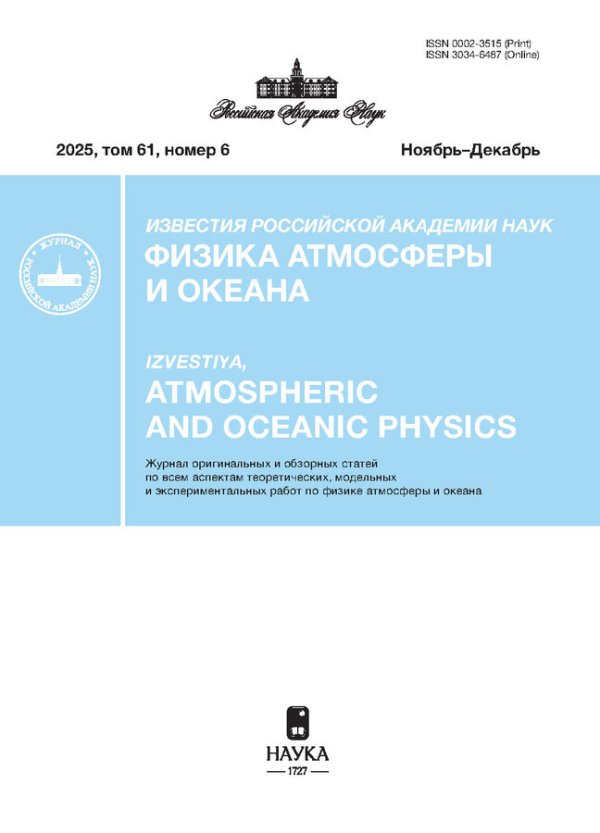Изменчивость экстремальных температур воздуха и осадков в конце XX и в начале XXI веков в различных природных зонах Земли по данным реанализа ERA5
- Авторы: Железнова И.В.1, Гущина Д.Ю.1
-
Учреждения:
- Московский государственный университет им. М.В. Ломоносова
- Выпуск: Том 59, № 5 (2023)
- Страницы: 549-559
- Раздел: Статьи
- URL: https://journals.rcsi.science/0002-3515/article/view/140360
- DOI: https://doi.org/10.31857/S0002351523050139
- EDN: https://elibrary.ru/ANDMWR
- ID: 140360
Цитировать
Полный текст
Аннотация
Глобальный рост температуры на планете сопровождается увеличением частоты возникновения экстремальных погодных событий, которые могут привести к значительным нарушениям в течении обменных процессов в растениях и функционировании растительных сообществ. В зависимости от типа растительности и климатических условий степень и характер такого влияния может значительно изменяться. Поэтому задачей настоящей работы было выявить районы с различными типами растительных сообществ, наиболее подверженные воздействию экстремальных температур и осадков в последние десятилетия. Для выявления регионов с экстремальными значениями температуры и осадков выбран метод оценки частоты превышения заданного порога (менее 5% квантиля или более 95% квантиля) для подобранных теоретических функций распределения плотности вероятности для рядов температуры воздуха и осадков. Для всего Земного шара рассчитано количество случаев превышения порога экстремальности, проанализирована их пространственно-временная изменчивость в различные сезоны года и в первые десятилетия XXI века по сравнению с концом XX века. Выявлены регионы с различными типами растительных сообществ, в которых отмечается наиболее выраженное усиление экстремальности режима температуры и осадков в условиях меняющегося климата.
Об авторах
И. В. Железнова
Московский государственный университет им. М.В. Ломоносова
Автор, ответственный за переписку.
Email: ijeleznova@gmail.com
Россия, 199911, Москва, Ленинские горы, д. 1
Д. Ю. Гущина
Московский государственный университет им. М.В. Ломоносова
Автор, ответственный за переписку.
Email: dasha155@mail.ru
Россия, 199911, Москва, Ленинские горы, д. 1
Список литературы
- Beck H.E. et al. Present and future köppen-geiger climate classification maps at 1-km resolution // Sci. Data. 2018. V. 5. P. 1–12.
- Beer C. et al. Terrestrial gross carbon dioxide uptake: Global distribution and covariation with climate // Science (80-.) . 2010. V. 329. № 5993. P. 834–838.
- Frank D.C. et al. Water-use efficiency and transpiration across European forests during the Anthropocene // Nat. Clim. Chang. 2015. V. 5. № 6. P. 579–583.
- Frank J., Massey J. The Kolmogorov-Smirnov Test for Goodness of Fit // J. Am. Stat. Assoc. 1951. V. 46. № 253. P. 68–78.
- Hansen J., Sato M., Ruedy R. Perception of climate change // Proc. Natl. Acad. Sci. USA. 2012. V. 109. № 37.
- Hersbach H. et al. The ERA5 global reanalysis // Q. J. R. Meteorol. Soc. 2020. V. 146. № 730. P. 1999–2049.
- Lavers D.A. et al. An evaluation of ERA5 precipitation for climate monitoring // Q. J. R. Meteorol. Soc. 2022. V. 148. № 748. P. 3152–3165.
- Lei X. et al. How Well Does the ERA5 Reanalysis Capture the Extreme Climate Events Over China? Part I: Extreme Precipitation // Front. Environ. Sci. 2022. V. 10. № June. P. 1–14.
- Li L. et al. Responses of greenhouse gas fluxes to climate extremes in a semiarid grassland // Atmos. Environ. 2016. V. 142. P. 32–42.
- Mahecha M.D. et al. Global convergence in the temperature sensitivity of respiration at ecosystem level // Science (80-.) . 2010. V. 329. № 5993. P. 838–840.
- O’Gorman P.A. Precipitation Extremes Under Climate Change // Curr. Clim. Chang. Reports. 2015. V. 1. № 2. P. 49–59.
- Parmesan C. et al. Chapter 2: Terrestrial and Freshwater Ecosystems and their Services. 2022. P. 197–378.
- Peel M.C., Finlayson B.L., McMahon T.A. Updated world map of the Koppen-Geiger climate classification // Hydrol. Earth Syst. Sci. Updat. 2007. V. 11. P. 1633–1644.
- Reichstein M. et al. Climate extremes and the carbon cycle // Nature. 2013. V. 500. № 7462. P. 287–295.
- Seneviratne S.I. et al. Weather and Climate Extreme Events in a Changing Climate // Climate Change 2021: The Physical Science Basis. Contribution of Working Group I to the Sixth Assessment Report of the Intergovernmental Panel on Climate Change / под ред. V. Masson-Delmotte et al. Cambridge, United Kingdom and New York, NY, USA: Cambridge University Press, 2021. P. 1513–1766.
- Shapiro S.S., Wilk M.B. An Analysis of Variance Test for Normality (Complete Samples) // Biometrika. 1965. V. 52. № 3/4. P. 591–611.
- Smith M.D. The ecological role of climate extremes: Current understanding and future prospects // J. Ecol. 2011. V. 99. № 3. P. 651–655.
- Tabari H. Climate change impact on flood and extreme precipitation increases with water availability // Sci. Rep. 2020. V. 10. № 1. P. 1–10.
- Weibull W. A Statistical Distribution Function of Wide Applicability // J. Appl. Mech. 1951. V. 103. P. 293–297.
- Xu W. et al. How Well Does the ERA5 Reanalysis Capture the Extreme Climate Events Over China? Part II: Extreme Temperature // Front. Environ. Sci. 2022. V. 10. № June. P. 1–15.
- Zhao M., Running S.W. Drought-induced reduction in global terrestrial net primary production from 2000 through 2009 // Science (80-.) . 2010. V. 329. № 5994. P. 940–943.
- Zscheischler J. et al. Detection and attribution of large spatiotemporal extreme events in Earth observation data // Ecol. Inform. 2013. V. 15. P. 66–73.
- Zscheischler J. et al. A few extreme events dominate global interannual variability in gross primary production // Environ. Res. Lett. 2014a. V. 9. № 3.
- Zscheischler J. et al. Impact of large-scale climate extremes on biospheric carbon fluxes: An intercomparison based on MsTMIP data // Global Biogeochem. Cycles. 2014b. V. 28. № 6. P. 585–600.
- Zscheischler J. et al. Extreme events in gross primary production: A characterization across continents // Biogeosciences. 2014c. V. 11. № 11. P. 2909–2924.
Дополнительные файлы















